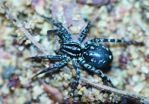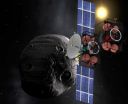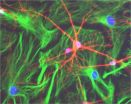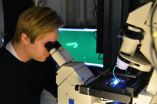However, the mechanisms behind sap exudation—processes that trigger pressure differences causing sap to flow— in maple trees are a topic of much debate. In a paper published today in the SIAM Journal on Applied Mathematics, authors Maurizio Ceseri and John Stockie shed light on this subject by proposing a mathematical model for the essential physiological processes that drive sap flow.
Sugars are produced in the leaves of the maple tree by photosynthesis with the help of absorbed water, carbon dioxide, and sunlight, and are consumed for current growth, or stored as starch. In the cold, dormant season, some of the starch enters the sap, where it remains mostly frozen until the spring. In the period between this dormant state and the active growing season (during cold nights with below-freezing temperatures followed by mild, warm days with above-freezing conditions), the stored starch is converted into sugar and the sap pressure grows, allowing it to exude naturally from the tap hole when tapped.
"The root causes of sap exudation before the onset of the growing season, which allow trees like maple to be tapped for sap in commercially exploitable quantities, have been debated in the biology community for decades," explains co-author John Stockie. "Several possible mechanisms have been proposed, but until now, no one has developed a complete mathematical model that adequately explains which mechanisms are actually required. Resolving this controversy is the main purpose of our work from a botanical standpoint."
The "physical" model of sap exudation attributes the mechanism entirely to pressure and volume changes that result from passive, physical effects in the tree's vascular tissue: expansion and contraction of gas as well as freezing and thawing of sap, which occur in response to temperature changes.
Experimental evidence supports this physical model, and the current understanding is that gas trapped in vascular tissue is compressed by growth of ice crystals and water uptake when the tree freezes in colder months; when the tissue subsequently thaws in the spring, the compressed gas expands, which generates the pressure that causes exudation. Osmotic pressure, which exists due to differences in sugar concentration between different components of the vascular tissue helps maintain stable gas bubbles, thus allowing the freeze/thaw mechanism to cause sap flow.
The model in the paper is based on this currently understood mechanism for internal pressure build up in maple trees. Using a system of differential algebraic equations, which govern the multiphase gas-liquid-ice environment, the model incorporates the dynamics and effects of thawing sap, dissolving gas bubbles and an osmotic pressure gradient between two components (vessels and fibers) in the tree's non-living vascular tissue. On the cellular level, the model focuses on the transfer of pressure between vessels and fibers in the vascular cells.
Using numerical simulation, the authors validate the model: They conclude that compression of gas effected by freezing in the previous season is important for pressure build up. The effect of gas bubbles is also necessary to allow transfer of pressure, which causes exudation. While osmosis is not essential for the pressure generation itself, it is seen to maintain gas bubbles, which help in creating the pressure differences necessary.
This work goes a long way in explicating the physical effects that play a role in the mechanism of sap exudation. However, as Stockie explains, "Our paper considers only the thawing process. To capture the build-up of pressure observed in actual maple stems, we must also include the freezing process, as well as multiple freeze/thaw cycles. This is work in progress."
"On the commercial side, we plan to ultimately develop a "complete" model of sap flow in a maple tree that can be used in sugarbush management and optimizing sap harvests," he continues. "A full-tree model for sap flow will be useful in optimization studies. We are studying how to 'scale-up' these cell-level freeze/thaw processes into a tree-level model."
The authors have and appreciate the opportunity to interact regularly with maple syrup producers. "These are people that come from a surprising variety of backgrounds, ranging from farmers to retired teachers to construction company owners, including very few scientists and no-one (yet) with a background in advanced mathematics," says Stockie. "Nonetheless, we find that maple syrup producers have a real enthusiasm for our work and are excited by the potential for mathematics to contribute to their understanding of very practical problems for the industry."
Hence, according to Stockie, the researchers are constantly bombarded with questions like: What effect will recent climate changes have on future sap yields? Why does a light snow cover around the trunk have such a big influence on stem pressures? Why does sap flow drop immediately after a west wind? "These are questions we can't answer yet," he says. "But our aim is to come up with a model that will!"
###
Source Article:
A Mathematical Model of Sap Exudation in Maple Trees Governed by Ice Melting, Gas Dissolution, and Osmosis
Maurizio Ceseri and John Stockie
SIAM Journal on Applied Mathematics, 73(2), 649–676 (Online publish date: March 6, 2013).
The source article is available for free access at the link above until June 6, 2013.
About the authors:
John Stockie is an associate professor of mathematics and Maurizio Ceseri a postdoctoral researcher at Simon Fraser University in Surrey, British Columbia. This work was supported by grants from the Natural Science and Engineering Research Council of Canada, Mprime Network of Centres of Excellence, and North American Maple Syrup Council.
About SIAM
The Society for Industrial and Applied Mathematics (SIAM), headquartered in Philadelphia, Pennsylvania, is an international society of over 14,000 individual members, including applied and computational mathematicians and computer scientists, as well as other scientists and engineers. Members from 85 countries are researchers, educators, students, and practitioners in industry, government, laboratories, and academia. The Society, which also includes nearly 500 academic and corporate institutional members, serves and advances the disciplines of applied mathematics and computational science by publishing a variety of books and prestigious peer-reviewed research journals, by conducting conferences, and by hosting activity groups in various areas of mathematics. SIAM provides many opportunities for students including regional sections and student chapters. Further information is available at http://www.siam.org.
[Reporters are free to use this text as long as they acknowledge SIAM]
END



